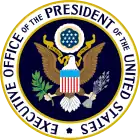White House Office of Intergovernmental Affairs
The White House Office of Intergovernmental Affairs is a unit of the White House Office, within the Executive Office of the President. It serves as the primary liaison between the White House and state, county (or county-equivalent), local, and tribal governments.[1][2] The office focuses on building new and maintaining current relationships with governors, tribal leaders, mayors, state legislators, and county executives.[1][2] The Office of Intergovernmental Affairs works with federal agencies and departments to ensure appropriate coordination between state, local, and tribal governments and the federal government.[1] The Director of Intergovernmental Affairs at the White House Office for the Biden administration is Julie Chavez Rodriguez.[3]
 | |
| Agency overview | |
|---|---|
| Formed | 1955 |
| Headquarters | Eisenhower Executive Office Building Washington, D.C., U.S. 38°53′51.24″N 77°2′20.93″W |
| Agency executive |
|
| Parent department | White House Office |
Origin
The Office of Intergovernmental Affairs was established in 1955 by President Dwight D. Eisenhower when he appointed former Arizona Governor John Howard Pyle as Special Assistant to the President for Intergovernmental Affairs. The appointment followed the recommendations of the Kestnbaum Commission on Intergovernmental Relations, which had been established by Congress to study problems in the interactions between federal and state governments.[4]
References
- "Readout of the White House Forum on State and Federal Relations". 2017-09-13.
- Pazniokas, Mark (January 19, 2017). "Justin Clark named to White House staff". The Connecticut Mirror. Retrieved June 6, 2017.
- "Julie Rodriguez - Director of the White House Office of Intergovernmental Affairs". Biden-Harris Transition. Retrieved December 12, 2020.
- Patterson, Bradley H. (1994). "Teams and Staff: Dwight Eisenhower's Innovations in the Structure and Operations of the Modern White House". Presidential Studies Quarterly. vol. 24 (No. 2): 277–298. JSTOR 27551241.
